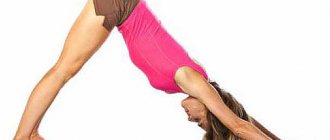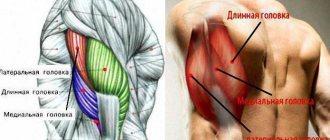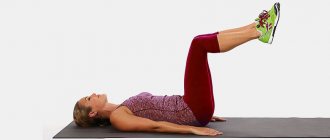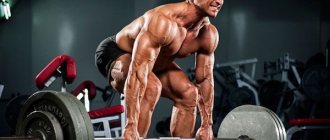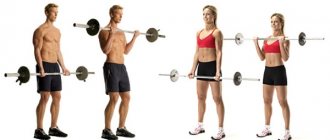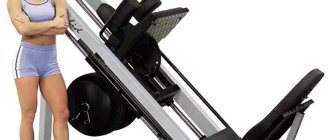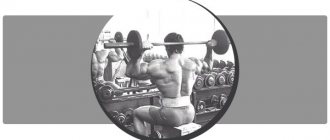Your orthopedist
Everything about the musculoskeletal system on one site: Back, Joints, Bones and more
Home › Treatment › Physical therapy › Gymnastics for the shoulder joint: video selection of physical exercises
Humeral periarthritis, arthrosis, tendonitis, bursitis, capsulitis, plexitis, shoulder-hand syndrome, sprains, subluxations and dislocations, internal and periarticular fractures, joint instability... There are quite a lot of diseases and types of traumatic injuries of the articulation of the head of the humerus with the glenoid cavity of the scapula . But the main method of treatment is one - gymnastics for the shoulder joint.
To effectively treat pain, you need to find out its cause and make a diagnosis.
The videos presented in this article were compiled by various doctors who are “popular” on the Internet. And although the exercises in them will be “the same,” their order and the load received during the exercise therapy session pursue different goals, which depend not so much on the name of the disease, but on its degree, the period of treatment and the condition of the shoulder.
Therefore, before you start performing any set of exercises for the shoulder joint that you like, get approval from your doctor, and if acute pain occurs, immediately stop the exercise and seek advice.
- How does exercise for the shoulder joint treat it?
- Massage of elbow and shoulder joints
- Gymnastics for pain in the shoulder joint from Dikul
- Therapeutic exercise for the shoulder joint from Dr. Evdokimenko
- Exercise therapy for the shoulder joint from Bubnovsky
- Yoga for shoulders from Vyacheslav Smirnov
How does exercise for the shoulder joint treat it?
Scientists have experimentally proven, and medical practitioners confirm that the therapeutic effect increases and the healing time is reduced if the patient knows how the medicine “works”. The same applies to physical therapy, the main varieties of which are presented in the photo below.
Forms of exercise therapy – gymnastics (exercises: passive, active, with objects, on simulators) and swimming
Regularly performed and properly selected gymnastics for the shoulder joints causes a local increase in blood flow and lymph drainage, due to which the following effects are expected and possible:
- acceleration of metabolism in the affected and nearby tissues;
- inhibition or stopping of inflammatory processes;
- reduction or complete disappearance of pain;
- normalization of synovial fluid production - resorption of excess, stimulation in case of deficiency;
- although insignificant, but still, an increase in the rate of cellular regeneration;
- reducing and/or preventing the development of swelling of the soft tissues surrounding the joint;
- preventing the formation of muscle atrophy, adhesions and contractures leading to stiffness;
- restoration of the integrity of bones, cartilage, ligaments, tendons and bursa tissue;
- full rehabilitation of the amplitude and directional vectors of movements, muscle strength, and elasticity of connective tissue.
Attention! It is important to correctly dose exercise therapy for diseases of the shoulder joints. Its insufficiency will not give the desired results and may increase the healing time. On the other hand, the price for too zealous treatment and too much physical activity is the development of immediate and delayed complications, which can result in disability, require a change of profession and replacement of the joint with an artificial one.
Sports nutrition to speed up rehabilitation
Since cartilage is damaged first, special attention should be paid to taking chondroprotectors. Their regular use protects cartilage and ligaments from wear and tear. The use of these supplements in the post-traumatic period allows for faster restoration of damaged tissue.
You need to take vitamin complexes, because vitamins ensure normal metabolism. Their deficiency disrupts metabolism.
Due to the fact that bone and cartilage structures consist of mineral components, it is necessary to replenish the losses of these substances. Otherwise, repeated injury cannot be avoided. An increased content of vitamins and minerals in the diet accelerates the process of tissue regeneration and allows you to quickly restore shape.
For those who are just deciding whether they need sports nutrition, we recorded a video below:
We recommend: a sports nutrition boutique with an exclusive range from the USA!
Massage of elbow and shoulder joints
An important auxiliary part of the treatment of pathologies and injuries of the shoulder is therapeutic massage. It improves tissue trophism, reduces swelling, brings relief and reduces pain. In addition to completing a course of procedures with a specialist, which is recommended for chronic diseases once every 6 months, self-massage of the shoulder joint is also indicated.
It is recommended to do it after waking up, before going to bed and before starting exercise therapy. In the latter case, it can be considered as the first warm-up exercise for the shoulder joint, which will take no more than 1.5 minutes.
The technique and rules for self-massaging are simple. You can familiarize yourself with them by watching the following video.
Gymnastics for pain in the shoulder joint from Dikul
The exercises presented below can be performed to relieve pain from glenohumeral periarthritis and other degenerative or inflammatory pathologies of the shoulder.
For 5 days, morning afternoon and evening, do 4 simple exercises from the video. To perform this you will need a gymnastic stick or a 3 kg body bar. Dosage - according to sensations, until you feel slightly tired. Between series of movements of the same type, you can and should pause to rest.
After 5-7 days (individually), increase the load by adding 4 more exercises to the first 4 for pain in the shoulder joint. Reduce the number of classes to 2 – morning and evening.
You will need:
- light dumbbells that can be replaced with small plastic bottles, adjusting the weight with the volume of water, starting from the minimum;
- rug;
- fitball or chair.
Next, after 1.5-2 months, when the weight of dumbbells of 1-1.5 kg does not cause “discomfort” when performing 15 repetitions of each exercise, add 4 more exercises to your complex to strengthen the shoulder joint and stabilize it.
It doesn't matter that there are no exercise machines at home. They can be replaced with elastic bands, securing them properly so as not to disrupt the biomechanics of movements. The load can be increased by adjusting their length or simply increasing the number of tapes.
In order for your set of exercises to develop the shoulder joint to be complete, it needs to be “enriched” with 4 more movements. Before looking for points of fixation of elastic bands, carefully familiarize yourself with the technique and directions of movements.
On a note. All the movements shown above, but with light weights, and initially without them at all, can be used as exercises for the development and rehabilitation of the shoulder joint after an intra- or periarticular fracture, subluxation or dislocation.
Exercises for arthrosis
This pathology develops in the cartilage tissue of the joint due to metabolic disorders and is accompanied by severe pain. The disease often appears during heavy physical exertion on the shoulder girdle. The main goal of treating arthrosis is to relieve pain and restore normal function of cartilage tissue.
Therapeutic exercises and massage of the shoulder girdle are the most basic activities carried out in the treatment of arthrosis. The main thing in the treatment of this pathological process is the regularity of the treatment complex and gentle loads on the joint.
Gymnastics using the Bubnovsky method, aimed at restoring active movements in the joint and relieving pain, gives a good effect in treatment. The exercises are easy to perform and can be done at home. Before gymnastics, a short warm-up is performed in a lying position, followed by a complex of exercise therapy:
- raise your arms up, spread them to the side and put them under your head;
- all exercises are done while exhaling with complete relaxation of the muscular frame of the thoracic region;
- in a sitting or standing position, dumbbells are lifted in front of you, the weight of which is from one to four kilograms. In each case, sports equipment of a certain weight is selected individually;
- sitting and stretching your arms forward with dumbbells, spread them to the sides. The exercise is repeated up to 20 times.
Read also…. Headache in the back of the head and neck
Bubnovsky’s methodological developments have several options, so before starting classes using his method, a doctor’s consultation is necessary.
Therapeutic exercise for the shoulder joint from Dr. Evdokimenko
Video exercises for shoulder plexitis can also be done for other pathologies. However, the doctor’s personal instructions indicate that there are also “forbidden” diagnoses for their implementation.
| Indications | Contraindications |
|
|
Perform the movements every day - morning and evening, for a month, gradually increasing the load and volume of movements. Be prepared to endure moderate, dull pain caused by stretching of the tendons. At first, their occurrence is almost inevitable. However, if they develop into acute ones, then you have gone too far with the load, and it should be reduced.
After 45-60 days of movement treatment, you can switch to a maintenance mode - exercise 5-6 times a week, only in the morning. Don't forget to do self-massage before class.
Attention! Dr. Evdokimenko warns. Even when performed correctly, therapeutic exercises for the shoulder joint will not give instant or quick results. The pain may get worse during the first 14 days. Improvement in condition and well-being usually occurs within a month.
Exercise for Chronic Diseases
Chronic pathology, in the form of glenohumeral periarthritis, is a common disease in the middle and older generation. The inflammatory process affects the periarticular tissues of large joints. Common causes are osteochondrosis of the cervical spine, traumatic injury to the shoulder girdle, and increased loads.
Complex treatment using exercise therapy and physiotherapy gives a pronounced effect in relieving clinical symptoms. Popov’s therapeutic exercises, which are performed in the morning, are recognized as the best method for treating glenohumeral periarthritis. Exercises are repeated up to ten times:
- sitting on the edge of a chair and placing your feet apart, you walk in place, while your hands slide down your thighs;
- smooth and slow movements of the shoulder girdle. Bending and unbending, the movements are repeated;
- with arms extended in front of you, shoulder movements are made in the form of a figure eight;
- When inhaling, move your shoulders forward, when exhaling, cross your arms over your chest;
- circular movements with elbows;
- feet shoulder width apart. Leaning forward, reach your feet facing inward. When straightening, bring your shoulder blades together, while your feet are turned outward;
- hands lie on the shoulders, elbows stretch upward;
- As you inhale, raise your arms up, and as you exhale, lower them.
All exercises are performed while sitting. This technique allows you to successfully cope with the disease of the joints of the shoulder girdle and develop the activity of movements of the affected organ.
Rehabilitation for this pathology always takes a long time. But strict adherence to all medical recommendations and regular exercise therapy exercises have a positive effect.
Exercise therapy for the shoulder joint from Bubnovsky
Many patients suffering from glenohumeral periarthritis benefit from an integrated approach invented by sports rehabilitation specialist Sergei Bubnovsky. He suggests doing exercises to relieve shoulder pain on a block, which you can replace at home with a rubber band, while applying an ice pack to the sore spot.
Try doing it as shown in the video. Perhaps this approach will help solve your problem.
On a note. Physical therapy for shoulder replacement and exercises after shoulder surgery begin with passive development with the help of an instructor! Further “independent activities” of the operated patient are categorically unacceptable. The joint is developed according to a special plan, and upon discharge, lesson notes are given.
Yoga for shoulders from Vyacheslav Smirnov
Any disease is easier to prevent than to cure. The proposed video complex - Yoga for the shoulder joints, will be a good addition to daily morning exercises.
The asanas are suitable for those who are at the final stage of recovery from an injury, “keep” a chronic disease “under control” or for the first time feel discomfort or mild pain in the shoulders.
And in conclusion, we give you another very useful video clip. It talks about how to conduct independent preliminary testing to determine the cause of pain in the shoulders. And it also tells in what cases and what diagnostic or additional treatment procedures will be needed.
